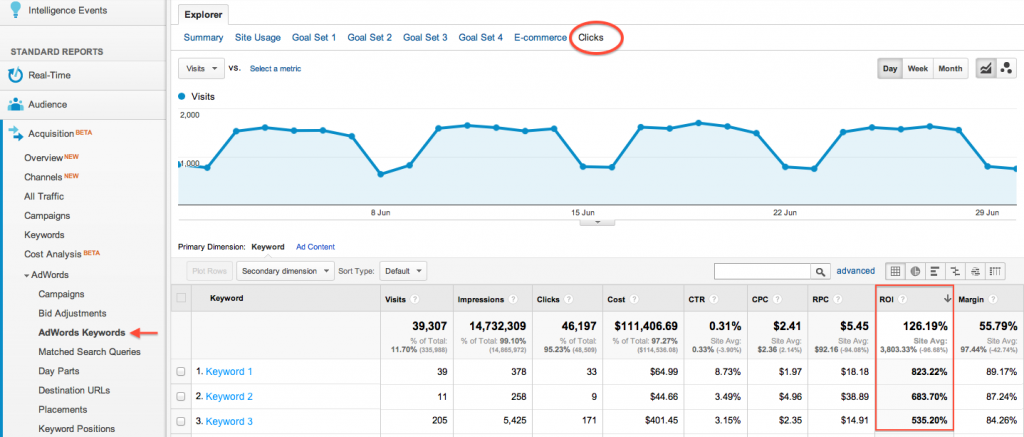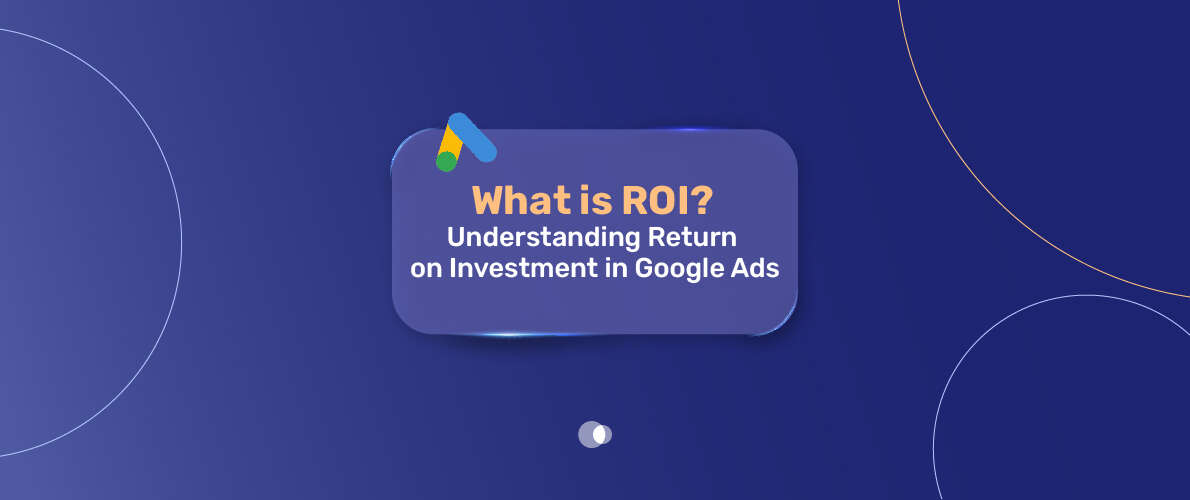Everyone involved in digital marketing constantly asks: What is ROI? Any business using Google Ads should focus on measuring ROI to see how well they are doing and find ways to improve their results. Return on Investment in Google Ads demonstrates the relationship between how much you spend on advertising and the amount of money earned from it. This article will focus on what you need to understand about Google Ads ROI such as its formulas, value, and steps you can take to improve it. At the end, you’ll know how to maximize your campaigns for greater profits.
Table of Contents
What is ROI? What Does ROI Mean in Digital Advertising?
To sum up, ROI refers to a sales measurement that looks at the earning potential of any investment. Your campaigns’ ROI from Google Ads is the money made versus the money spent on advertising. Unlike click-through or cost-per-click, ROI helps link the advertising you do with the actual money you earn from your business
In simple terms, ROI tells you if the money you spend on Google Ads is worth it. Higher revenue than what you invested is a high ROI, but low ROI usually suggests losses and inefficient work.

How to Calculate ROI in Google Ads
You need to know the total revenue and the total money spent on advertising to find out the ROI for Google Ads. The formula is straightforward:
ROI = (Revenue – Advertising Cost) / Advertising Cost x 100
For example, Suppose you paid $500 for Google Ads and earned $2,000 from it; your ROI would be:
ROI = ($2,000 – $500) / $500 x 100 = 300%
The formula makes it possible to know which ads or strategies are giving you the highest returns.
Why ROI Matters More Than Basic Metrics
To assess the results of a marketing campaign, most businesses look at simple measurements like CPA, CTR or CPC. Even though they are helpful in some cases, they rarely present the full outline of what’s happening in a campaign. Here is when the ROI (Return on Investment) brings real value. But what is ROI, and why does it hold such importance for businesses?
Basically, ROI determines the profitability of an investment by comparing the total profit to the invested cost. Advertising ROI tells you how much money you earn for every dollar invested in advertising. While other factors can be easily tracked, ROI gives a complete picture of a campaign and checks if all the money spent is properly accounted for. This is why ROI is regarded as a more useful and essential metric.
1. Revenue-Driven Insight
The main benefit of ROI is that it links the outcome of ads with how much revenue is earned. Knowing CPA and CTR allows you to understand data such as your ad’s clicks and the price needed to convert a customer. Still, these data do not provide insight on whether the clicks or acquisitions have led to actual profits. Unlike other metrics, ROI helps businesses see how their campaigns perform financially.
For example, a campaign with low pay per acquisition may seem like a smart choice, yet if the customers do not bring in much revenue, the campaign could still turn out as a fail. By focusing on ROI, businesses can ensure that their advertising efforts align with overall profitability goals.
2. Profitability Evaluation
ROI goes beyond surface-level efficiency and dives into profitability. This helps discover which marketing activities are bringing in the greatest profits. Even if CTR is high for a campaign, it won’t last if the expenses outweigh the revenue generated. Also, a campaign that has a smaller CTR but better ROI might still be the best.
By tracking ROI, businesses can allocate their marketing budget to the campaigns that deliver the most profit. As a result, each spending decision is made carefully to maximize profits from advertising dollars. Having no ROI makes it simple to invest in appealing campaigns that do not generate income.
3. Strategic Decision-Making
Comprehending ROI and how to apply it can revolutionize the approach companies take when planning their marketing. ROI provides actionable insights that go beyond basic performance metrics, empowering marketers to optimize their campaigns for maximum returns. A company can, for example, take advantage of ROI data in the following ways:
- Adjust bids: If some of your efforts on campaigns or keywords bring a high ROI, you can invest more money in them to earn more profits.
- Refine targeting: ROI shows where marketers should place their focus on customers that are most valuable.
- Improve ad creatives: When marketers notice which ads make the best return, they can make their creatives more appealing to their users.
Following this approach helps with proper division of resources, better results from the campaign and increased profits.
The Big Picture
Metrics like CPA, CTR and others can tell you about particular areas of a campaign, but they do not take into account whether the campaign is profitable. ROI brings all the elements together by highlighting revenue and profit. When businesses focus on ROI, they guide their marketing, use resources wisely and see that marketing helps them develop as a company.
So, the next time you evaluate your marketing campaigns, ask yourself: What is ROI, and how can it help you achieve your goals? By shifting your focus to this powerful metric, you’ll gain the clarity needed to drive sustainable growth and profitability.
How to Improve ROI in Google Ads
Having explored ROI, let’s see what can be done to improve it:
1. Set Clear Goals
Define what success looks like for your campaigns. Whether it’s lead generation, e-commerce sales, or app installs, having a clear objective helps you measure ROI effectively. Using a professional Google Ads agency account ensures your campaigns are aligned with measurable goals and optimized for ROI
2. Focus on High-Value Keywords
Applying keywords such as “buy” or “shop online” can boost the number of sales you make. Google Keyword Planner is one tool that can point out profitable keywords that attract less competition.
3. Optimize Your Landing Pages
Your landing page must align with your ad copy and offer a seamless user experience. Features like fast load times, compelling CTAs, and mobile responsiveness can significantly improve conversion rates.
4. Use Conversion Tracking
Tracking conversions is easy using the tools in Google Ads. You can better gauge your ROI by assigning the right values to your purchases or leads.
5. Leverage Smart Bidding
Google’s automated bidding strategies, such as Target ROAS or Enhanced CPC, use AI-powered algorithms to optimize Google Ads account in real-time and maximize returns.
6. Segment Campaigns by Performance
Create your ad groups so that each one is targeted to a specific audience. With this strategy, you manage your budgets properly and can see which approaches are most effective.
7. Implement Negative Keywords
Negative keywords prevent your ads from showing up for irrelevant searches, saving money and improving ROI. For example, if you have premium shoes in your store, you could opt not to use keywords such as “cheap shoes.”
Common Challenges in Measuring ROI
Measuring ROI isn’t without its challenges. Here are a few obstacles businesses often face:
- Attribution Problems: It can be challenging to find out which elements in a campaign drove someone to convert. Utilizing multi-touch attribution can lead to a better understanding.
- Incomplete Data: Without proper conversion tracking, it’s impossible to calculate accurate ROI. Ensure all touchpoints are tracked, from clicks to sales.
- Long Sales Cycles: For B2B or high-value products, sales cycles are often lengthy, making it harder to attribute revenue to specific campaigns. Extending your conversion window in Google Ads can help.
For businesses new to paid advertising, choosing to buy Google ads account from trusted providers can simplify the setup process and ensure accurate tracking from the start to finish.
Using ROI to Evaluate Campaign Success
To truly understand what ROI is, you must continuously evaluate and optimize your campaigns. Following this quick list will help you succeed:
- Regularly monitor campaign performance in Google Ads.
- Adjust bids and budgets based on ROI data.
- Test new ad creatives and landing page designs.
- Use A/B testing to identify winning strategies.
- Focus on customer lifetime value (CLV) for long-term ROI.
If your campaigns are underperforming, taking steps to fix Google Ads account issues, such as improving conversion tracking or refining targeting, can drastically increase ROI.
Final Thoughts: Understanding ROI for Smarter Google Ads Strategies
Simply put, learning about ROI is important because it helps you choose actions that increase profits. By measuring ROI in your Google Ads campaigns, you can identify what’s working, eliminate inefficiencies, and allocate resources more effectively. Whether you focus on e-commerce advertising or lead generation, the level of ROI tells you how well things are going.
Ready to maximize your Google Ads ROI? At Admoon, As a leading Google Ads agency in UAE, we specialize in creating high-performing campaigns tailored to your business goals. Contact us today for a free consultation, and let’s turn your advertising budget into measurable growth!



